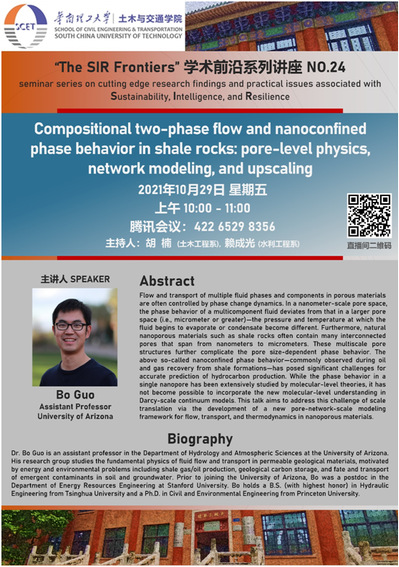题目:页岩中的组分双相流和纳米受限相行为:孔隙级物理、网络建模和尺度放大
Compositional two-phase flow and nanoconfined phase behavior in shale rocks: pore-level physics, network modeling, and upscaling
时间:2021年10月29日周五10:00-11:00
地点:腾讯会议 ID:42265298356
腾讯直播间:https://meeting.tencent.com/l/QALGLWoVMAcS
报告人:郭波(美国亚利桑那大学,水文与大气科学系)
欢迎广大师生参加!
土木与交通学院
2021年10月27日

报告人简介:
郭波博士是美国亚利桑那大学水文与大气科学系的助理教授。他的研究小组专注于渗透性地质材料中流体流动和传输的基础物理研究,旨在解决相关能源和环境问题,例如页岩气/石油生产、地质碳储存以及土壤和地下水中突发污染物的命运和传输等问题。在加入亚利桑那大学之前,郭博士先后在清华大学水利工程系获学士学位(优秀毕业生),普林斯顿大学获土木与环境工程博士学位,在斯坦福大学能源工程系的进行博士后工作。
Dr. Bo Guo is an assistant professor in the Department of Hydrology and Atmospheric Sciences at the University of Arizona. His research group studies the fundamental physics of fluid flow and transport in permeable geological materials, motivated by energy and environmental problems including shale gas/oil production, geological carbon storage, and fate and transport of emergent contaminants in soil and groundwater. Prior to joining the University of Arizona, Bo was a postdoc in the Department of Energy Resources Engineering at Stanford University. Bo holds a B.S. (with highest honor) in Hydraulic Engineering from Tsinghua University and a Ph.D. in Civil and Environmental Engineering from Princeton University.
报告摘要:
多孔材料中多种流体相和组分的流动和传输通常由相变动力学控制。在纳米级孔隙空间中,多组分流体的相行为与较大孔隙空间(即微米级或更大尺寸)中的相行为有所不同——流体开始蒸发或冷凝时的压力和温度变得不同。此外,天然纳米多孔材料(如页岩)通常包含许多相互连接且从纳米尺度到微米尺度的孔隙。这些多尺度孔隙结构进一步使受孔径影响的相行为复杂化。
在页岩地层油气开采过程中常见的上述所谓纳米受限相行为对准确预测油气产量提出了重大挑战。虽然分子水平的理论已经对单个纳米孔中的相行为进行了广泛的研究,但将对分子水平新的理解纳入到达西尺度连续介质模型中是不现实的。本讲座旨在介绍一种可以解决这类尺度转换挑战,且适用于多孔材料流动、传输和热力学的孔隙网络尺度模型框架。
Flow and transport of multiple fluid phases and components in porous materials are often controlled by phase change dynamics. In a nanometer-scale pore space, the phase behavior of a multicomponent fluid deviates from that in a larger pore space (i.e., micrometer or greater)—the pressure and temperature at which the fluid begins to evaporate or condensate become different. Furthermore, natural nanoporous materials such as shale rocks often contain many interconnected pores that span from nanometers to micrometers. These multiscale pore structures further complicate the pore size-dependent phase behavior.
The above so-called nanoconfined phase behavior—commonly observed during oil and gas recovery from shale formations—has posed significant challenges for accurate prediction of hydrocarbon production. While the phase behavior in a single nanopore has been extensively studied by molecular-level theories, it has not become possible to incorporate the new molecular-level understanding in Darcy-scale continuum models. This talk aims to address this challenge of scale translation via the development of a new pore-network-scale modeling framework for flow, transport, and thermodynamics in nanoporous materials.



